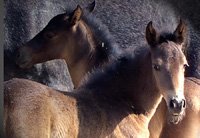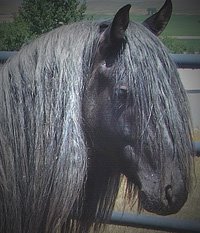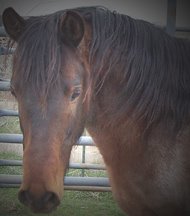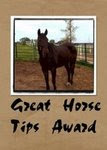Consolation, however, is a different story. She's lead mare in our herd and until recently had never in her life been more than a hundred feet away from her fellows. I discovered late last year that all her attentiveness and respect in the round corral vanished as soon as we stepped outside her comfort zone.
Herdbound behavior is very common, and it can be at its worst when the horse in question is dominent in the herd. Not only does such a horse have an ingrained sense of responsiblity toward the herd, but she is also accustomed to taking control of a situation that frightens her rather than depending on another horse (or human) to provide direction. In Consolation's case, this meant that leading her away from the group resulted in frenzied neighing and struggling for control.
Now that I'm on the verge of starting Consolation under saddle, then conditioning her for endurance, the time has come for Consolation to break free of the herd. I started the process about three weeks ago, after I was confident that several pre-requisites were firmly in place:
1) She understood giving to pressure, particularly halter pressure. This meant that even in frightening situations, she would not "run through" the halter and get loose.
2) She understood lateral and vertical flexion, and could turn on the forehand and hindquarters from either side. These tools would be useful for redirecting her attention and making her work.
3) She understood lunging and direction changes on the lunge. This would provide a safe way to blow off steam if necessary, as well as another means of making her work.
Our first lesson consisted of leading through the gate and stopping at the point Consolation grew nervous -- which was only about 15 feet away. We stood there until she calmed down, then headed back to the round corral, where we practiced flexion for several minutes. Then, we went back out, back in, out and in, lather, rinse, repeat. The principles I was communicating were these:
1) You don't need to worry about leaving. We will always come back.
2) Coming back is not about food and relaxation. We work when we're home, but you get to rest when we're away.
We finished the first lesson having gone no more than 40 feet away from the familiar compound. The next day, we went as far as 100 feet. Within the week, we were able to loop clear around the house -- which briefly blocked the other horses from view -- and back, working each time we returned and relaxing while away.
By the end of the second week, we could go a quarter mile down the road. Whenever she started to lose focus or get panicky, I'd ask for a simple task, such as trotting in hand, circling, or flexing vertically and backing, to recall her attention.
All seemed well, but I often find that just when I think a horse has accepted a lesson, there's one more, big blowup to come. It's as though the horse learns what is expected, then gives it a hard test before accepting it for good.
Consolation's blowup happened last Wednesday. While on our customary jaunt down the road, she grew increasingly agitated in response to the other horses' neighs. My attempts to regain her attention worked for only moments at a time, resulting in further correction and an ensuing battle of wills. As Consolation's frustration grew, and I had to remind myself that my emotions have no place in my training. I need to deal with the issue at hand, calmly and fairly. Any escalation must be at the horse's initiative, not mine.
 We made it back home, and I put into action the plan I'd formed during our contentious return journey. I set Consolation to lunging at the end of the ten-foot lead rope. At first, she blasted around me as quickly as possible (but always respecting pressure on the halter), keen to release pent-up energy. Several minutes and multiple direction changes later, however, the effort involved in balancing at speed on a small circle began to sink in.
We made it back home, and I put into action the plan I'd formed during our contentious return journey. I set Consolation to lunging at the end of the ten-foot lead rope. At first, she blasted around me as quickly as possible (but always respecting pressure on the halter), keen to release pent-up energy. Several minutes and multiple direction changes later, however, the effort involved in balancing at speed on a small circle began to sink in.I kept her going past the point of comfort, then calmly gathered her up and started down the road again. We hadn't gone far when she grew agitated. As soon as I could regain her attention and take a few, calm steps forward, we headed back...and lunged some more.
I didn't time the lesson, but I'd guess we spent almost two hours repeating the going-away-is-easy, coming-home-is-hard pattern. Finally, Consolation remained calm and attentive for a walk away from home and back. I lunged her a few, final rounds, then brushed her sweaty neck and called it good.
 That lesson seems to have been the break- through she needed. Whereas a month ago, I couldn't easily lead her out the driveway, we're now taking almost-daily walks out across the valley.
That lesson seems to have been the break- through she needed. Whereas a month ago, I couldn't easily lead her out the driveway, we're now taking almost-daily walks out across the valley.There are few things as bonding as being out with a horse, two mere specks in a vast landscape, with nothing but a little rope and a lot of trust holding you together.
Congratulations on breaking free, M'Lady. Here's to thousands of miles together.
_____________________________________
Related Posts
Where To, Ma'am: First Trail Ride on a Green Horse
Thinking it Through: Training Horses as Individuals
Connecting the Dots: Breakthroughs in Horse Training
Moving Out: Increasing Speed and Confidence on the Trail
_____________________________________
Want to read more posts like this one? We deliver!









1 comment:
I like this account. Good image, conceptually, on the process.
:)
sj
Post a Comment